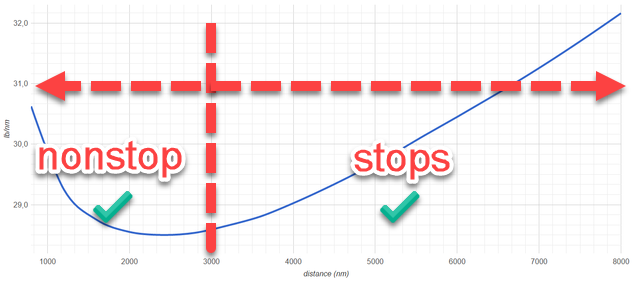The 7:1 rocket figure is perhaps for the unrealized single-stage-to-orbit, getting a payload to low Earth orbit (LEO) is closer to 9:1, and going to the moon and back is 23:1 (Saturn V).
If a soda can's content is the fuel, then the rocket stages that are jettisoned have better fuel to empty mass ratio compared to that soda can, so staging is not the main reason why the figures are higher than the 7:1.
- This is important because if a 5-hour flight is getting to LEO, then an ultra-long-haul 16-hour flight is the equivalent of going to the moon and back.
This already tells us there is no general rule of thumb for flight planning (or space flight). But, there is a common figure that is used when highlighting the benefits of carrying the right amount of fuel.
0. A common figure: 15%.
According to Simon Weselby, a Fuel and Emissions Performance Manager at Airbus, that figure is 15%. So to carry 1,000 kg of fuel, an extra 150 kg will be burned.
According to the famous lift-to-drag ratio graph, carrying fuel in cruise is not a big deal as the induced drag decreases with speed. The challenge is getting a heavy plane off the ground and getting it up to speed.*
If the fuel fraction mid-flight for a long-haul jet is 20%. Then that means the thrust required to carry 20% of the weight is 10% of the thrust (if the induced drag equals the form drag at the minimum drag point).
* That's why above a certain range, it becomes more economical to make stops. This takes into account the fuel alone. Not taking into account the passenger convenience, aircraft cycles, the maintenance cost of the extra takeoff thrust, etc.
That relationship is demonstrated by the graph below.

(Wikipedia) Takeoff, climb, step-climbs, etc., are accounted for, i.e., those are the averages for complete flights, not just cruise.
I've used the same 777-200 data that was used in making that graph to come up with different ways to look at your question, which can be answered in more than one way (the previous 15% figure is the easy answer).
1. If the fuel was weightless problem first.
I've used the most economical range (average fuel flow) as a baseline. And from there found out how much fuel is wasted to carry the extra fuel for the extra range.
NM kg
2800 0 0%
3200 230 1%
3600 420 1%
4000 750 2%
4400 1130 2%
4800 1760 4%
5200 2350 4%
5600 3180 6%
6000 4060 7%
6400 4990 8%
6800 6080 9%
7200 7260 10%
7600 8590 11%
8000 9970 12%
Going from 2800 NM to 8000 NM, 9970 kg are wasted carrying the heavier fuel, or 12% of the total fuel load.
The fuel fractions for 2800 NM and 8000 NM are 18% and 40%. The aforementioned 15% figure for the A330 at 2500 NM matches that of a 777-200 at 2400 NM.
2. Problem two: carrying more fuel for the same trip distance.
This is equivalent to payload. What it does is increase the landing weight (LW). A quick and dirty way to check how much extra will be burned carrying more fuel that will not be used is to use the same fuel fraction for that distance.
This is what the Airbus presentation says, which I've been able to verify in a spreadsheet for 5 different weights 22.7 tonnes apart. (And also for the 737 for good measure.)

(Own work) Click to view full table.
For example, if our baseline flight needs 15% fuel fraction, it will still be 15% of the new higher weight (landing weight + trip fuel). In other words, if the LW goes up, the trip fuel goes up.
For the 777-200, landing weights of 136,100 and 226,800 kg need 25,400 and 37,800 kg of fuel for a 2400 NM trip. Or 15.7% and 14.3% fuel fractions.
An 8000 NM trip needs a fuel fraction of 40.3% for the lowest landing weight I calculated, and 38.8% for the heaviest.
So the quick and dirty rule of thumb is to maintain the fuel fraction for the same trip distance.
3. Percent of Landing Weight (LW) per hour.
A different way to look at it: I've constructed the graph below for the 777-200. As you can see, it matches the trend of the Wikipedia one.

(Own work)
So for a 6-hour flight, it will be 6 times 3.6, or 21.6% of the LW in fuel.
While a 0.5% is negligible for a 737 and maybe even for a 777 on short routes, it is not when it is multiplied by long flight durations.
Below is yet another way to look at the data, the average fuel flow per engine in kg per hour for the different trips.
NM FF/eng (kg/hr)
800 2510
1200 2460
1600 2440
2000 2450
2400 2450
2800 2450
3200 2470
3600 2480
4000 2490
4400 2510
4800 2540
5200 2560
5600 2580
6000 2610
6400 2640
6800 2660
7200 2690
7600 2720
8000 2750



